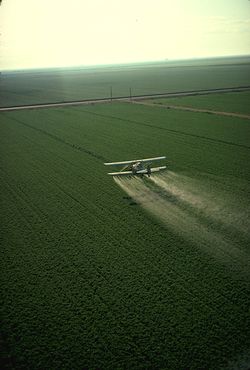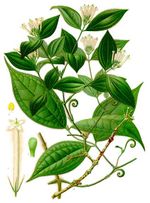تاريخ السموم
تاريخ السموم[1] تعود إلى 4500 قبل الميلاد. سموم الوقت الحاضر. قد استخدمت لأغراض كثيرة في مختلف أنحاء الوجود الإنساني ، والأكثر شيوعا مثل الأسلحة و مضادات السموم و الطب . السموم سمحت بالكثير من التقدم في فروع الطب ، علم السموم ، و التكنولوجيا وغيرها، من بين العلوم الأخرى.
تم اكتشاف السموم في أوقات العصور القديمة ، وكانت تستخدم من قبل القبائل البدائية والحضارات كأداة لتسريع الصيد وضمان وفاة الفرائس أو الأعداء. نما هذا الإستعمال للسموم الأكثر تقدما ، وكثير من هذه الشعوب القديمة بدأت تزويد الأسلحة المصممة خصيصا لتعزيز سميتها. في وقت لاحق في التاريخ ، وبخاصة في وقت الإمبراطورية الرومانية ، واحدة من أكثر إستخدامات السموم انتشارا كان الإغتيال. في اقرب وقت من 331 قبل الميلاد ، وحالات التسمم المنفذة على مائدة العشاء أو في المشروبات قد تم ورودها في تقارير، والممارسات أصبحت شائعة. وينظر الى استخدام مواد قاتلة بين كل طبقة اجتماعية ، وحتى النبلاء أستخدمت السموم في كثير من الأحيان للتخلص من المعارضين السياسيين أو غير المرغوب فيهم من الإقتصاديين.
أصل السموم
| الأثري النتائج أثبتت أنه في حين أن بشرية بدائية استخدمت الأسلحة التقليدية مثل الفؤوس والهراوات ، والسيوف في وقت لاحق ، ووسائل أكثر دقة ، مما تسبب الموت المدمر —وهو ما يمكن تحقيقه من خلال تسميم الخصوم و الأعداء.[2] تم العثور على الأخاديد لتخزين السموم في عقد مثل tubocurarine في أسلحة الصيد ، والأدوات ، والتي تبين أن البشر قد اكتشفوها في وقت مبكر وهى أنواع من السموم بدرجات قوة متفاوته التى إستخدموها في أسلحتهم.[2] بعض <! -- من؟ --> التكهنات بأن هذا الاستخدام لوجود هذه المواد الغريبة والضارة يظل سرا داخل أعضاء أكثر أهمية وأعلى مرتبة ، من القبائل أو العشائر ، وكان ينظر اليها على انها أكبر من شعارات السلطة . وقد يكون هذا أيضا نظرا لتاريخ مفهوم النمطية في " رجل الطب " أو "طبيب شعبي ".[2]
تاريخ السموم في مصر القديمة
على عكس العديد من الحضارات ، فإن السجلات القديمة لمصر القديمة) والمعارف لإستخدام السموم سوف تعود إلى ما يقرب من 300 قبل الميلاد. ومع ذلك ، يعتقد أن أقرب البيانات المعروفة للفرعون المصري ، مينا ، الذى درس خصائص النباتات السامة والسموم ، وفقا للسجلات في وقت مبكر. بعد هذا ، ومع ذلك ، يمكن تتبع الأدلة المعرفة للسموم في مصر البطلمية إلى كتابات باحث يشتغل بالكيمياء القديمة القديمة ، Agathodiamon (حوالي 100BC) ، الذي تحدث عن المعادن (مجهولة الهوية) التي عندما تمزج مع النطرون أنتجت سما ناريا. ووصف هذا السم بأنه يمتزج بالماء ويختفى معطيا محلولا رائقا .[3] Clive Emsley قد خمن أن 'التسميم الناري' وثالث أكسيد الزرنيخ ، والمادة المعدنية مجهولة الهوية بعد أن تم إما realga أو orpiment ، وذلك بسبب العلاقة بين المعادن مجهولة الهوية وكتاباته الأخرى.[3]
ويعتقد أيضا أن المصريين قد وصلوا إلى معرفة عناصر مثل الأنتيمون و النحاس و الزرنيخ الخام و الرصاص و [[الأفيون] ، و (نبات) اللفاح (وغيرهم).تم الكشف عن أسرار أخرى في هذه أوراق البردي .و المصريين هم أول أعتقد أنهم أول من أجاد عملية التقطير, وإستخلاص السموم التي يمكن الحصول عليها من حبات الخوخ..[2]
وأخيرا قيل أن كليوباترا يمكن أن تكون قد سممت نفسها بإستخدام asp بعد أن علمت بمصرع ماركوس أنتونيو '. وقيل أنها قبيل وفاتها قد أرسلت العديد من وصيفاتها ليكن بمثابة حقل تجارب لاختبار السموم المختلفة ، بما في ذلك (نبات) البيلادونا ، henbane ، و الاستريكنين الشجرة والبذور.[4]
Middle Ages
Later, in Europe during the Middle Ages, when the nature of poisons were known better than simply as magic and witchcraft, there were sellers and suppliers of potions and poisons, known as apothecaries.[5] Despite the fact that the medicinal uses of poisons were now known, it was no secret that people bought poisons for less useful and lawful reasons. The alchemists who worked in these apothecaries suffered a considerable risk to their health, working so invariably close to poisonous substances.[6] At the same time, in other areas of the world, the technological advancement of poisons was expanding, and in the Arab nations, some had succeeded in making arsenic transparent, odourless and tasteless when applied to a drink, a method which would allow poison murderers to remain undetected for at least one millennium.[7]
An excerpt from Chaucer's The Canterbury Tales, a text that existed sometime in the 14th century to the 15th century describes a killer buying poison from an apothecary to rid a rat infestation:
And forth he goes—no longer he would tarry—
Into the town unto a ‘pothecary
And prayed him that he woulde sell
Some poison, that he might his rattes quell…
The ‘pothecary answered: "And thou shalt have
A thing that, all so God my soule save,
In all this world there is no creature
That ate or drunk has of this confiture
Not but the montance of a corn of wheat
That he ne shall his life anon forlete.
Yea, starve (die) he shall, and that in lesse while
Than thou wilt go a pace but not a mile
The poison is so strong and violent— Canterbury Tales—The Pardoner's Tale. Lines 565-581.
This is one example of work of literature related to poison; poisons and potions were a very popular subject particularly in fiction, such as in Shakespeare's works. There were also academic texts discussing the subject, and both non-fiction and fiction were written for the most part by monks, whose knowledge and wisdom were respected, and as such authored a large portion of published works on the subject.[5]
One example of a non-fiction work is The Book of Venoms, a book describing the known poisons of the time, their effects and uses, written by Magister Santes de Ardoynis in 1424. It also recommended the best known treatments for a given poison. Despite this, it is considered probable that these factual works were not released to the public, but kept within appropriate learned circles for study and research.[5]
الوقت الحاضر
| Poison/Drug | Antidote | |
|---|---|---|
| paracetamol (acetaminophen) | N-acetylcysteine[8] | |
| vitamin K anticoagulants, e.g. warfarin | vitamin K, Protamine[8] | |
| narcotics/opioids | naloxone[9] | |
| iron (and other heavy metals) | deferoxamine[8] | |
| benzodiazepines | flumazenil[8] | |
| ethylene glycol | ethanol or fomepizole[9] | |
| methanol | ethanol or fomepizole[9][10] | |
| cyanide | amyl nitrite, sodium nitrite, and sodium thiosulfate[8][11] | |
In the late 20th century, an increasing number of products used for everyday life proved to be poisonous. The risk of being poisoned nowadays lies more in the accidental factor, where poison be induced or taken by accident. Poisoning is the 4th most common cause of death within young people. Accidental ingestions are most common in children less than 5 years old.
However, hospital and emergency facilities are much enhanced compared to the first half of the 20th century and before, and antidotes are more available. Antidotes have been found for many poisons, and the antidotes for some of the most commonly known poisons are shown in the table above:
However, poison still exists as a murderous entity today, but it is not as popular form of conducting murder as it used to be in past times, probably because of the wider range of ways to kill people and other factors that must be taken into consideration. One of the more recent deaths by poisoning was that of Russian dissident Alexander Litvinenko in 2006 from lethal polonium-210 radiation poisoning.[12]

استخدامات أخرى
Today, poison is used for a wider variety of purposes than it used to be. For example, poison can be used to rid an unwanted infestation by pests or to kill weeds. Such chemicals, known as pesticides,[13] have been known to be used in some form since about 2500 BC. However, the use of pesticides has increased staggeringly from 1950, and presently approximately 2.5 million tons of industrial pesticides are used each year.[14] Other poisons can also be used to preserve foods and building material.
في الثقافة
Today, in many developing peoples of countries such as certain parts of Africa, South America and Asia, the use of poison as an actual weapon of hunting and attack still endures.
In Africa, certain arrow poisons are made using floral ingredients, such as of that taken from the plant Acokanthera. This plant contains ouabain, which is a cardiac glycoside, oleander, and milkweeds.[15] Poisoned arrows are also still used in the jungle areas of Assam, Burma and Malaysia. The ingredients for the creation of these poisons are mainly extracted from plants of the Antiaris, Strychnos and Strophanthus genera, and Antiaris toxicaria (a tree of the mulberry and breadfruit family), for example, is used in the Java island of Indonesia, as well as several of its surrounding islands. The juice or liquid extracts are smeared on the head of the arrow, and inflicts the target paralysis, convulsions and/or cardiac arrest, virtually on strike due to the speed in which the extracts can affect a victim.[16]
As well as plant based poisons, there are others that are made that are based on animals. For example, the larva or pupae of a beetle genus of the Northern Kalahari Desert is used to create a slow-acting poison that can be quite useful when hunting. The beetle itself is applied to the arrow head, by squeezing the contents of the beetle right onto the head. Plant sap is then mixed and serves as an adhesive. However, instead of the plant sap, a powder made from the dead, eviscerated larva can be used.[17]
انظر أيضاً
- Visha Kanya
- Chinese alchemical elixir poisoning
- Forensic science
- List of chemical elements
- List of Extremely Hazardous Substances
- List of poisonings
- Poison
- Toxicity
مراجع وملاحظات
- ^ السم يعرف بأنه "أى مادة تتسبب في الموت أو الأصابة بأعراض مميتة عندما يتم إبتلاعها أو إمتصاصها ." Colins Dictionaries, from the Bank of English (2001). Collins English Dictionary. HarperCollins. p. 594. ISBN 0007666918.
- ^ أ ب ت ث "Ancient poisons". Retrieved 1 April 2007.
{{cite web}}: Unknown parameter|dateformat=ignored (help) - ^ أ ب Emsley, pp. 2-3
- ^ Readers Digest. (1986). Magic and Medicine of Plants. Pleasantville, N.Y: Reader's Digest Association. p. 389. ISBN 0-89577-221-3.
- ^ أ ب ت "Medieval poisons". Retrieved 1 April 2007.
{{cite web}}: Unknown parameter|dateformat=ignored (help) - ^ خطأ استشهاد: وسم
<ref>غير صحيح؛ لا نص تم توفيره للمراجع المسماةemsley2 - ^ "A Brief History of Poisoning". BBC. Retrieved 21 April 2007.
{{cite web}}: Unknown parameter|dateformat=ignored (help) - ^ أ ب ت ث ج Poison Antidotes Archived 10 أبريل 2007 at the Wayback Machine. Retrieved on 21 April 2007.
- ^ أ ب ت Emergency Medical Department. Retrieved 21 May 2007. Archived 9 أكتوبر 2007 at the Wayback Machine
- ^ Mycyk MB, Leikin JB (2003). "Antidote review: fomepizole for methanol poisoning". American Journal of Therapeutics. 10 (1): 68–70. doi:10.1097/00045391-200301000-00015. PMID 12522524.
- ^ For a study by the IPCS on antidotes of cyanide, see this study.
- ^ Litvinenko, Alexander. "HPA Press Release". Health Protection Agency. Archived from the original on 26 نوفمبر 2006. Retrieved 10 يناير 2008.
- ^ What is a Pesticide? (US EPA definitions) retrieved 24 June 2006
- ^ Miller, G. Tyler Jr. (2002). Living in the Environment (12th Ed.). Belmont: Wadsworth/Thomson Learning.
- ^ "African arrow poison ingredients". Retrieved 28 April 2007.
- ^ "Poisoned Arrows". Retrieved 30 April 2007.
- ^ "Animal Based Poisons Today – Kalahari Beetle". Archived from the original on 26 April 2007. Retrieved 30 April 2007.
- Emsley, John (May 2005). The Elements of Murder: A History of Poison. New York: Oxford University Press. ISBN 0-19-280599-1.
للاستزادة
- Eleanor Herman (2018). The Royal Art of Poison: Filthy Palaces, Fatal Cosmetics, Deadly Medicine, and Murder Most Foul. St. Martin's Press. ISBN 978-1250140869.

